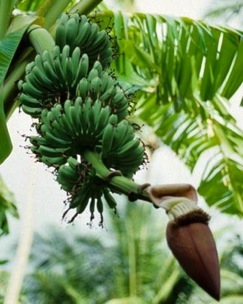Growth Cycle



Menu
Rhizome & Suckers...
Pseudostems & Leaves...
Inflorescence & Bunch...
The banana plant resides in every tropical climate on earth.
Rhizome & Suckers...
Members of the genus Musa produce fibrous root systems from the base of a rhizome. Primary roots in groups of three or four grow both vertically and horizontally down towards gravity. These roots are about 5 to 8 mm thick and white in color. From each primary root , a secondary ( lateral) and tertiary (hairlike) roots develop for support. The secondary roots emerge from the primary roots and the tertiary roots emerge from the secondary roots. The main functions associated with these adventitious roots are gathering nutrients and minerals and to provide structure and support for the plant.
The mature rhizome is about 300mm in diameter varying on climate conditions. Externally the rhizome is laced with leave scars that work as an epidermal layer of protection. Internally lies a central cylinder and cortex, surrounded by ground tissue primarily parenchyma. The primary function of the rhizome is to provide storage and development of a sucker. The sucker contains the primary meristem that transforms into an inflorescence. The rhizome also produce 3-5 vegetative buds that grow into suckers, promoting a new primary meristem.
After harvest the leaves, pseudostem and fruit stalk die back and one of the vegetative buds receives the job of being the new primary meristem. There are two types of suckers sword suckers and water suckers. Water suckers have broad leaves and a narrow rhizome node while sword suckers have narrow leaves and a broad rhizome. The dominant sword sucker is closely associated with the parent rhizome gaining food and nutrients from it. The sword sucker eventually becomes the new primary meristem after harvest of the parent rhizome plant.
Leaves & Pseudostem...
Leaves of the banana plant are continuously growing. The first leaves on a developing sword sucker are called scale leaves narrow and small. These are soon overtaken by sword leaves which are intermediate to the common broad leaves of a mature plant. Mature leaves can are on average 1.5 to 2.8 meters in length and 0.7 to 1.0 merers in width. The leaves are protected by tightly wound leave sheaths that are circular in shape and surround the meristem upon leaf emergence creating a trunk like structure called a pseudostem. The height of the pseudo stem can reach between 15 to 20 meters high.
Leaves are curled up inside the pseudostem being pushed through the ground tissue clear of the leaf crown. This process takes about 6 to 8 days to open fully. The leaf sheaths wrap the meristem restarting the process of leaf emergence. Eventually, the leaves are left behind as the plant continues to grow. These leafs die off, until the development of Inflorescence occurs.
Inflorescence & Bunch...
At this point the pseudostem ceases to grow and an inflorescence begins. This starts when the apical meristem rises into a dome. Flower bract appear female bracts followed by male bracts. These bracts have crescent shaped meristematic cushions that develop into flowers. The actual inflorescence is a comlex spike with nodes at both the basal (base or part closest to the ground) male flowered end and the distal ( top or closest to the top) female flowered end. The inflorescence is pushed out in the same manner as the leaves. The male bract upon harvest blooms into a brightly pink colored flower while the female bracts have developed into the delicious fruit we all love.
Fruit Development
In edible varieties of bananas, the fruit develops
by vegetative parthencarpy meaning the ovary
located in the female flower develops into a
mass of edible pulp without fertilization or
stimulus of pollination. This development brings forth fruits that are seedless. This phenomenon is still under research in determining the cycle of growth. But one thing is for sure human cultivation and activity has brought the hybridization of the banana to new levels. The now edible fruits form a cluster called a hand and each individual fruit is called a finger. The fruit is a berry and has a leathery outer protective layer that is also slightly fibrous and fleshy. The yield of each new sucker/ banana plant relies heavily on weather conditions, soil conditions and growing season.





